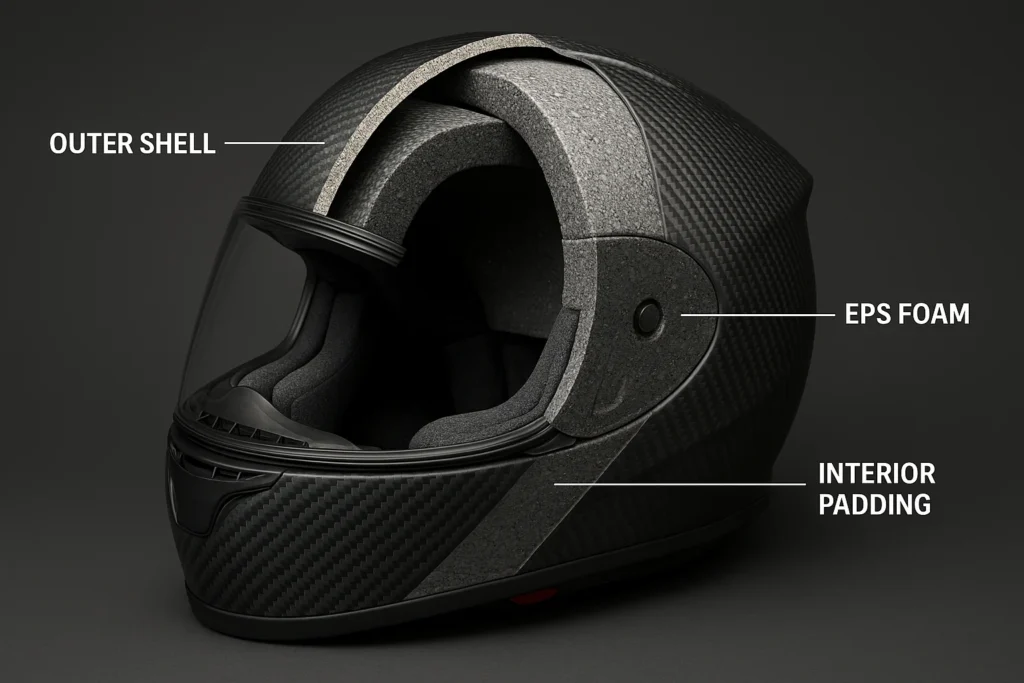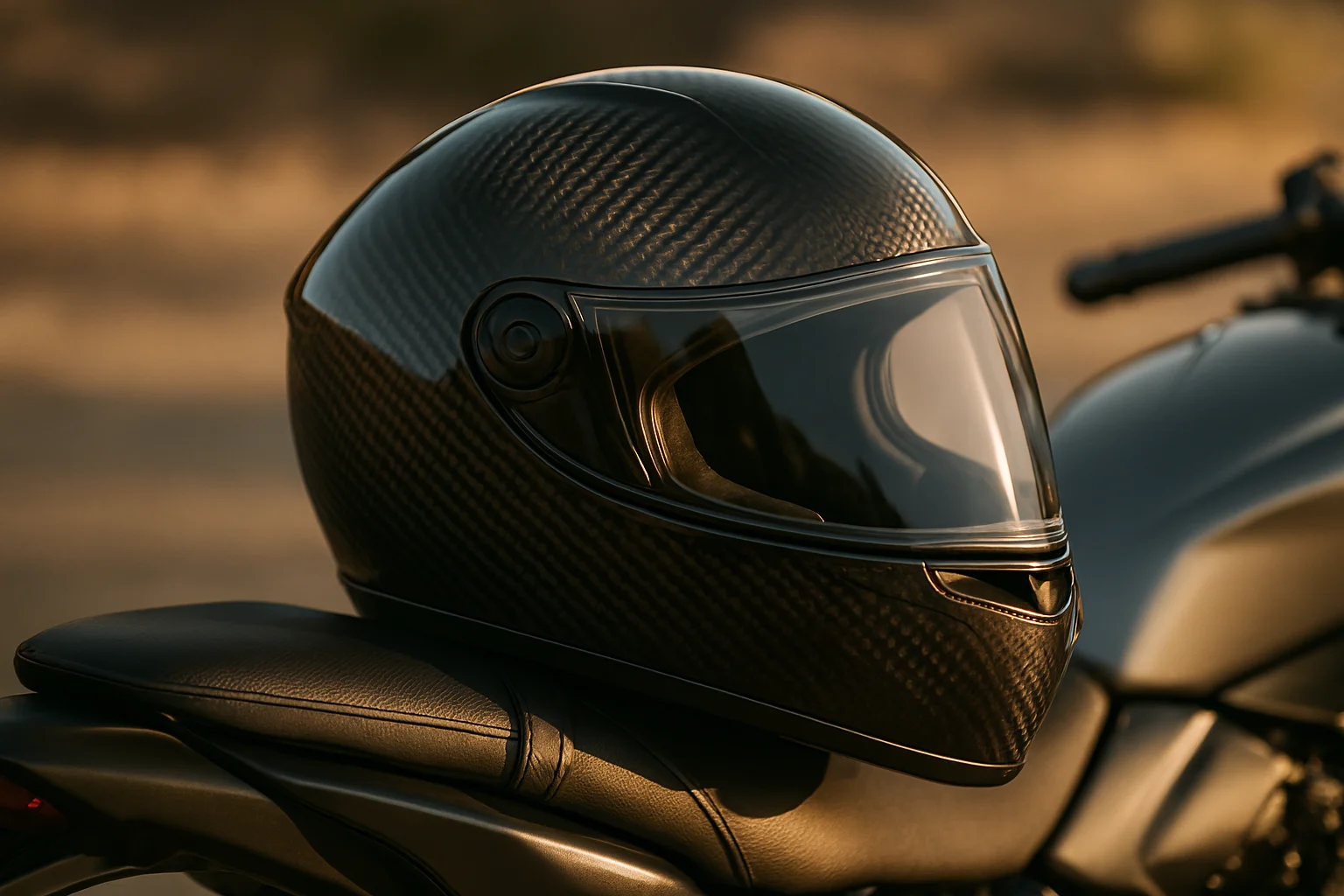I still remember my first motorcycle ride. The thrill, the wind in my face, and the rush of freedom were unforgettable. But one thing made me feel safe enough to push the throttle, my helmet. So, what are motorcycle helmets made of?
It wasn’t just any helmet; it was the result of a lot of research, trying on different models, and understanding what motorcycle helmets are made of. If you’re a rider like me, you’ll know that a helmet is not just gear, it’s your lifeline.
This guide is for fellow bikers who want to know exactly what’s protecting their head. I’ll walk you through each part of a helmet, explain why it matters, and share how I learned to choose the right one for my rides. Curious about helmet tech? Learn whether motorcycle helmets have Bluetooth and how it can elevate your ride.
What Are Motorcycle Helmets Made Of & Why Knowing Helmet Materials Matters for Riders
When I first got into biking, I didn’t care what my helmet was made of, I just wanted something that looked cool. That changed the moment I saw a rider in my local group walk away from a nasty fall without a scratch on his head. His helmet took the impact like a champ, and it made me realize that the materials inside a helmet can literally make the difference between life and death.

Motorcycle helmets aren’t made from random plastics. Every part, from the outer shell to the comfort padding, has been engineered to absorb shocks, reduce injury, and keep you riding another day.
The Outer Shell – Your First Line of Defense
The outer shell is what you see and feel when you pick up a helmet. For bikers, it’s like the armor on your head.
Fiberglass
One of my favorite helmets was made of fiberglass. It had that perfect mix of strength and lightness. Fiberglass is created by weaving fine glass fibers into a fabric and bonding it with resin. It spreads out the impact force so your skull doesn’t take the full hit. It’s perfect for long rides because it’s light enough not to strain your neck.
Polycarbonate
When I was just starting out, my first helmet was polycarbonate. It’s a type of tough plastic that’s injection-molded into shape. These helmets are affordable, reliable, and still meet safety standards. They can absorb a lot of energy without cracking. If you’re on a budget, polycarbonate helmets are a great choice.
Carbon Fiber
Now, for the dream helmets, carbon fiber. This material is incredibly light but incredibly strong. The first time I tried one, I almost forgot I was wearing it. It’s made by layering carbon fibers with resin, giving unmatched strength for its weight. Many pro racers and serious bikers swear by carbon fiber because it offers maximum protection with minimal weight. Considering Ruroc? Discover if Ruroc is a good brand before you buy, with pros, cons, and real user feedback.
The Inner Liner – Where the Real Impact Protection Happens
The liner sits under the shell and is the real hero in a crash.
Expanded Polystyrene (EPS) Foam
EPS is the white foam you see inside a helmet. I once accidentally dropped my helmet from my bike seat, the outer shell looked fine, but I replaced it anyway because EPS works by crushing under impact to absorb energy. If it’s compressed once, it won’t protect as well again.
Multi-Density Foam
Some of my higher-end helmets have multi-density foam, meaning softer foam in some spots and harder foam in others. Softer foam handles smaller knocks, while harder foam takes care of bigger impacts. It’s like having a helmet that adapts to different types of crashes.
Comfort Padding – Why Long Rides Don’t Feel Like Torture
I’ve done rides that last hours, trust me, comfort matters just as much as safety. The comfort padding makes sure the helmet fits snugly and doesn’t rub your skin raw.
Breathable Fabrics
A good helmet will have moisture-wicking fabric to keep sweat off your face. My summer helmet has microfiber lining, and it’s been a game changer on hot rides.
Anti-Microbial Treatment
Ever left your helmet in a hot garage after a sweaty ride? Yeah, it smells terrible. That’s why I always look for helmets with anti-microbial lining. It stops bacteria from growing, keeping the helmet fresher for longer. Safety first with Ruroc? Find out are Ruroc helmets safe and what crash test results show for your peace of mind.
How Motorcycle Helmets Are Designed and Built
When I visited a small helmet manufacturer last year, I got to see the process firsthand.
- Design Phase – They start with sketches and 3D models. It’s not just about looks, they calculate airflow, noise reduction, and impact resistance.
- Shell Molding – Depending on the material, they use either injection molding (for polycarbonate) or compression molding (for fiberglass and carbon fiber).
- Liner Creation – EPS foam is molded to fit perfectly inside the shell.
- Padding Installation – Comfort padding is stitched or snapped in place.
- Strap and Buckle Attachment – This part is reinforced because it must stay secure in an accident.
- Safety Testing – They smash helmets into steel anvils, drop them from heights, and test for penetration to meet safety certifications like DOT, ECE, or Snell.
Comparing Helmet Materials for Bikers
| Material | Strength Level | Weight | Cost | Best For |
| Fiberglass | High | Light | Mid | Touring and daily rides |
| Polycarbonate | Medium | Medium | Low | New riders and budget helmets |
| Carbon Fiber | Very High | Very Light | High | Racing and high-performance biking |
Real Biker Experience – Choosing the Right Helmet
When I bought my first carbon fiber helmet, I noticed the difference right away on long rides. My neck wasn’t sore after hours of cruising, and the ventilation kept my head cool. But I still keep a polycarbonate helmet as my backup because it’s affordable and perfect for short city rides.
If you ride in different weather, you might even need more than one helmet, I’ve got one for summer, one for winter, and one for track days. Budgeting for protection? See how much a motorcycle helmet costs based on quality, material, and safety rating—no surprises.
Why Helmet Certification is Non-Negotiable
Even the best materials mean nothing if the helmet isn’t safety certified. Always look for labels like:
- DOT – U.S. Department of Transportation standard
- ECE 22.06 – European safety standard
- Snell – High-performance safety standard for racing
I learned the hard way that cheap, uncertified helmets can look great but fail in real accidents. I’d never risk my head with one again.
Helmet Care for Longevity
I’ve made my helmets last years by following a few habits:
- Clean with mild soap and water only
- Store in a cool, dry place
- Never hang it on your bike’s mirror (it can damage the liner)
- Replace after 3–5 years or after any serious impact
How Helmet Technology is Evolving for Modern Riders
Back when I started riding, helmets were pretty simple, a hard shell, some foam, and a strap. They did the job, but technology has taken things to a whole new level. Today’s motorcycle helmets aren’t just about impact protection; they’re about comfort, visibility, communication, and even style, without sacrificing safety.
Advanced Impact Systems
One of the coolest features I’ve seen in newer helmets is MIPS (Multi-directional Impact Protection System). It’s a low-friction layer inside the helmet that lets the shell and liner move slightly during a crash. This reduces the rotational force on your brain, which is a big deal in preventing concussions. I tried a helmet with MIPS last season, and you wouldn’t even notice it’s there while riding.
Integrated Bluetooth and Intercoms
I used to stuff earphones under my helmet to listen to music or GPS directions. Now, many helmets come with integrated Bluetooth systems, so you can take calls, hear navigation prompts, or chat with your riding group without pulling over. On group rides, this is a game changer, no more awkward hand signals or pulling over just to plan the next stop.
Improved Ventilation and Noise Reduction
If you’ve ever ridden in midsummer heat, you know how much airflow matters. Modern helmets have adjustable vent systems that keep you cool on hot days and can be closed to stay warm in winter. Plus, better aerodynamics and padding design mean less wind noise, which is a relief on long highway runs.
Lighter but Stronger Materials
Carbon fiber used to be a luxury, but now even mid-range helmets are getting lighter shells without losing strength. I remember switching from a 1,600-gram helmet to one under 1,300 grams, my neck thanked me after the first day. Less weight also means less fatigue, which makes you a safer rider over long distances.
Custom Fit and Removable Liners
We all have different head shapes, and modern helmets are catching up to that fact. Many come with customizable cheek pads and crown liners that you can swap for a better fit. Plus, most liners are removable and washable, which is a must if you ride often in hot weather.
Helmets today are more advanced than ever, and as bikers, we’re lucky to have these innovations. Every upgrade, from better impact absorption to integrated tech, means a safer, more comfortable, and more connected ride. For me, the helmet has gone from being just protective gear to being a complete riding companion. Worried about laws? Check out are Bluetooth motorcycle helmets legal so you can ride connected and compliant.
Final Ride Thoughts
So, what are motorcycle helmets made of? The short answer: layers of science, engineering, and safety-focused design. The long answer is everything we’ve covered here, from carbon fiber shells to EPS liners and moisture-wicking padding.
As a biker, I know my helmet is my most important piece of gear. It’s saved my life once, and I’ll never ride without one. Whether you’re cruising through the countryside or leaning into tight corners on a track, understanding what’s protecting your head will make you a smarter and safer rider.
Ride safe, always. Read how long motorcycle helmets are good for and know when to swap for safety.





